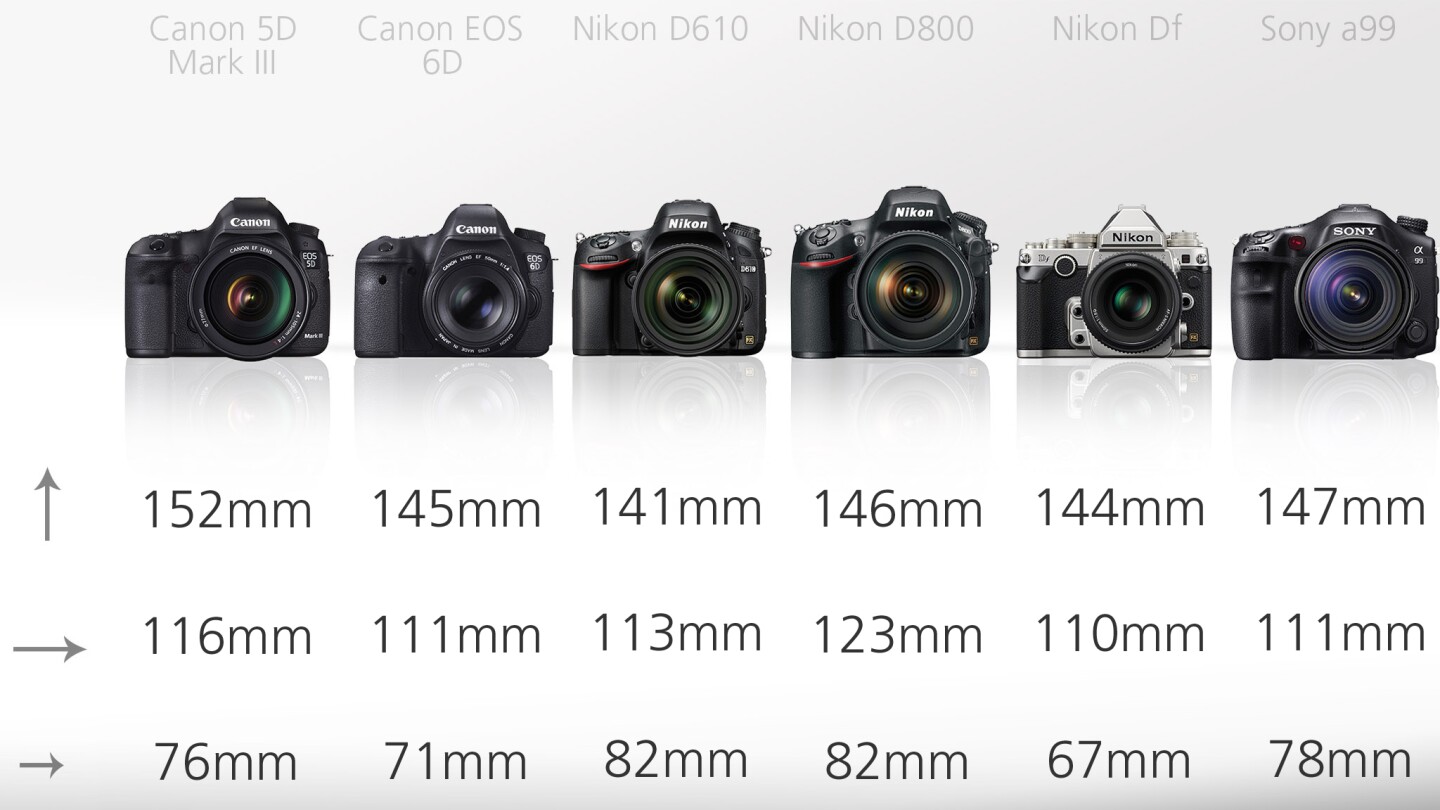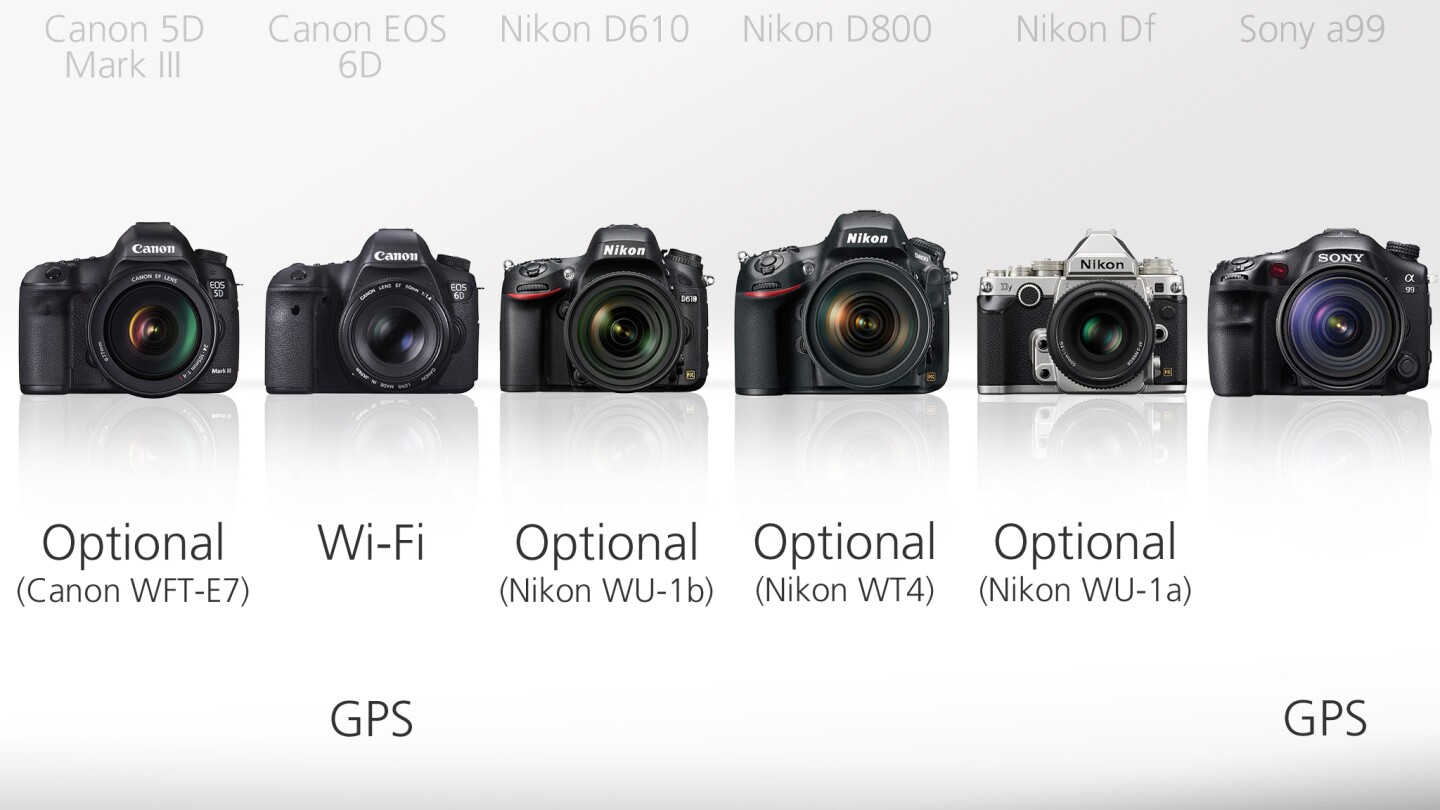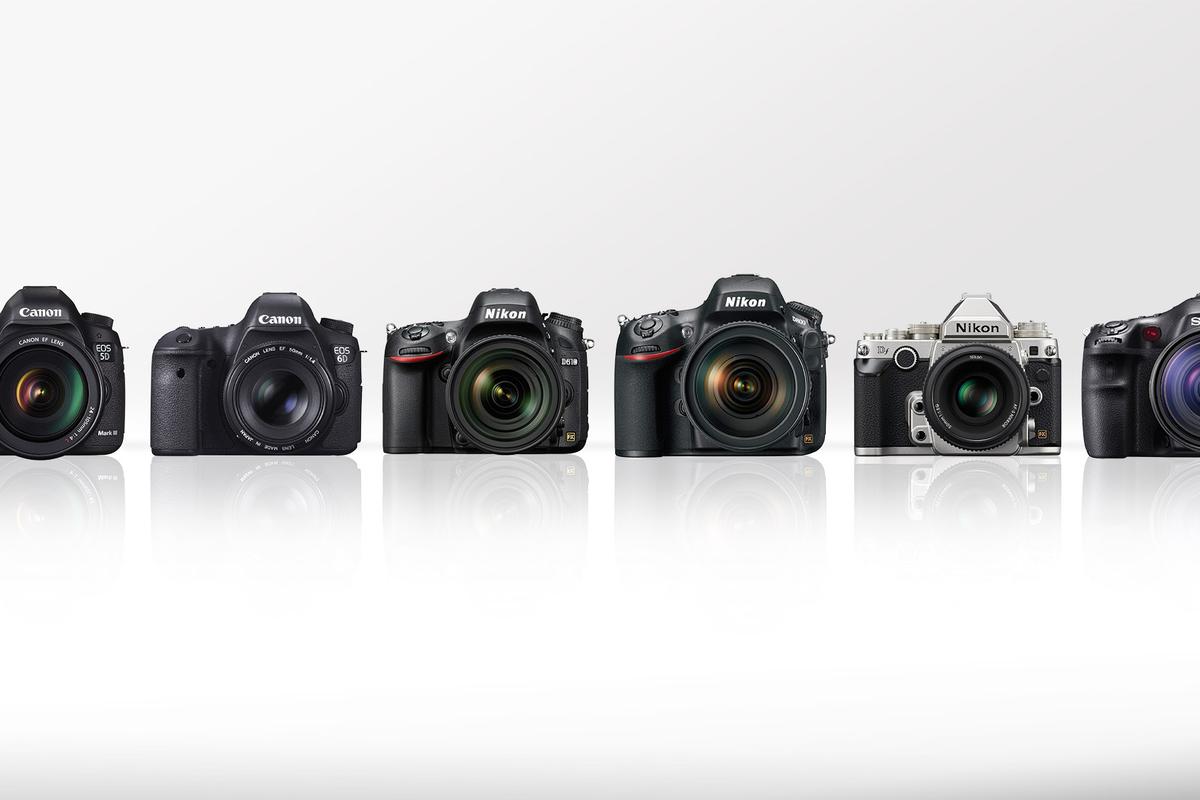Even entry-level DSLRs are now capable of producing very good quality images. But the high-end market, where cameras cost thousands of dollars, is about much more than that. These cameras are designed for enthusiasts and professionals who demand the ultimate in autofocus speed and manual controls, along with image and build quality. In this guide Gizmag compares our pick of the best high-end DSLRs currently on the market.
Meet the cameras
The high-end DSLR cameras we'll be comparing in this guide are:
You may notice that only two of these cameras, the Nikon D610 and Df, were released this year, and that all of those in our line-up are full frame devices. This is because in the DSLR world, the term "high-end" is increasingly meaning full frame, and those cameras are best compared only with each other.
While it's true that high-end DSLRs don't necessarily have to be full frame (APS-C sensor stalwarts are still waiting for worthy successors to the Nikon D300S and Canon 7D) at the moment they do tend to be. The best of the current crop of smaller sensor packing DSLRs, like the Nikon D7100 and the Canon 70D, are not quite of the same caliber as the cameras we're looking at here. As such we'll be featuring them in our upcoming mid-range DSLR comparison guide.
We've also opted not to include flagship cameras like the Nikon D4 and the Canon EOS 1D X in our guide. This is for the simple reason that people considering these professional models usually know exactly what they are looking for.
Size

The stand out camera in terms of size is the new Nikon Df. It's smaller, and considerably slimmer than most other full frame models. When compared to the big boys which are the Canon 5D III and Nikon D800, it's positively tiny. The Nikon D610 and the Canon EOS 6D are also each small enough that if you're moving up to them from a higher-end APS-C DSLR, they won't feel like too much of jump.
Weight

The Canon 6D and the Nikon Df are the lightest of our cameras weighing in at 755 g and 765 g with their respective batteries and memory cards, but without a lens. However, to put this into perspective, this is still almost double the weight of some of the high-end mirrorless cameras we recently looked at. The heaviest camera in our line-up is the Nikon D800 which comes in at a weighty 1,000 g.
Sensor Size

All of these cameras feature a large full frame sensor. As such, they will all be among the best performers in terms of image quality, irrespective of whether you are shooting in bright daylight or low-light conditions.
Megapixel Count

The lowest megapixel count of these cameras is the Nikon Df with its effective 16.2 megapixel sensor. However, this shouldn't be seen as a negative. In fact it's the very same high quality sensor which features in the flagship Nikon D4, where it has been very well regarded by many professional photographers.
At the opposite end of the scale is the Nikon D800 with its monster 36 megapixel sensor. This could be a good thing if you need the added detail for extra large prints or heavy crops, but those large files will require extra computer horsepower to process. The Canon 6D, Nikon D610, Sony A99 and the Canon 5D III all have comparable megapixel counts in the 20 to 24 range.
Autofocus

It's the Canon 5D III and the Nikon D800 which have the best autofocus systems of the bunch. The Canon has an impressive 61 focus point set-up with 41 cross types sensors, while the Nikon packs 51 focus points, with 15 cross type.
The new boys of the Nikon Df and D610 share the same system with 39 focus points (9 cross type) and the Sony A99 has 19 focus points with 11 cross type. But it's the Canon 6D which lacks in this regard, it's only able to boast 11 focus points of which a measly one is cross type.
FPS Burst Rate

We don't have any absolute speed demons in this line-up. If you need a blistering continuous shooting speed in DSLR form, you're going to be better served by a Nikon D4 or Canon 1D X. In fact, the top full frame speeds these cameras offer is 6 fps, though the Sony A99 is considerably faster if shooting in crop modes.
The updated Nikon D610 is now capable of 6 fps, from 5.5 fps in the D600, and has also gained a handy quiet continuous shutter mode. The slowest camera is the Nikon D800 which understandably can't process those huge files at speed. It maxes out at 4 fps for full frame capture, though can increase to 6 fps, if shooting in crop mode and with the added battery grip.
ISO Range

With big full frame sensors in each of the cameras we've picked, you know they're all going to be solid low-light performers, and the numbers back that up. While the Nikon trio each have top ISOs far lower than the 25,600 of the other cameras, they can be boosted to equivalent numbers. So if you absolutely must shoot at these settings, and don't mind the blotchy mess your images will result in being, you can.
Viewfinder

All of our true DSLRs feature optical viewfinders, and it's only the Canon 6D which fails to cover the full frame. This means images captured with it will be slightly wider than what was seen in the viewfinder.
Meanwhile, the Sony A99 reveals it's actually a STL (Single-Len Translucent) camera by using a electronic viewfinder. However, this isn't the poor quality EVF like those seen on cameras a few years ago. It has a super-sharp 2,359K dot equivalent resolution, has minimal lag, and can be used to display information not possible on an optical viewfinder.
Monitor

It's again the Sony A99 that stands out when it comes to its rear monitor. In addition to having the highest resolution, it's fully articulated, meaning it can be be used to make it easier to compose shots in awkward positions.
All of the other viewfinders are comparable with each other and come in at sizes between 3-inch and 3.2-inches and have resolutions ranging from 921K dots to 1040K dots.
Storage Media

Because DSLRs tend to be bigger than their mirrorless counterparts, they often have the option of using dual and different storage media. As they're frequently purchased by professionals, the Canon 5D III and the Nikon D800 both feature one Compact Flash slot in addition to an SD slot.
The Nikon D610 and the Sony A99 can both also take two cards, allowing for instant back-up, overflow storage or separating still and video files. However, while they both have two SD card slots, one of those on the Sony can also accept Memory Stick Pro Duo cards. The Canon 6D and the Nikon Df can each only take a single SD card.
File Type

As you would expect from cameras of this quality, they are all able to shoot JPEG and the RAW files that more demanding photographers insist on.
Construction

High build quality is something you should demand if dropping in excess of US$2,000 on a DSLR, and these cameras don't disappoint. While all feature magnesium alloy as part of their construction, it's the Nikon D800 and Canon 5D III which are the most impressive in this regard, and it helps to explain why they are so much heavier.
The Nikon Df also boasts a magnesium alloy top, rear and bottom in addition to dials carved from metal, adding to its solid feel. Even the Canon 6D and the Nikon D610, with their magnesium alloy plates are significantly more hardy than many other mid-range DSLRs.
Video Modes

When it comes to comparing video modes on these cameras, its the Nikon Df which is sure to get your attention. Not because it has the best video of the bunch, but because it doesn't do video at all. So, if video is your thing, the retro-styled shooter isn't the one for you.
Of the remaining cameras, the Sony A99 is the only one which can shoot Full HD 1080p video at 60 and 50 fps, though the others can all do it at 30/25/24 fps.
Audio

If you're going to shoot video on your DSLR, you'll probably want to use an external microphone rather than a built-in one. The good news is that all of the video capable cameras have an audio input socket. With the exception of the Canon 6D they also all feature an audio output so that you can monitor levels on headphones while recording.
Wireless Capabilities

Comparing wireless features of the high-end DSLRs is not as easy as when looking at mirrorless cameras. This is because some are aimed more towards professionals who have slightly different demands when it comes to wireless shooting and transferring images. As such, the optional wireless transmitters for the Canon 5D III and Nikon D800 are capable of sending images over a much greater distance, but are much more expensive.
The Nikon Df and D610 are compatible with more consumer-focused adapters which allow for wireless image sending and remote shooting via a smart device running the right app. However, the Canon 6D is the only one of the bunch which has these capabilities built-in. Earning it extra brownie points, it also boasts baked-in GPS for geotagging images.
Kit Lens

The more professional targeted cameras in our line-up are primarily available body-only, because their buyers are likely to already have a selection of glass at hand. However, kit lenses are commonly available with the others and the good news is that they're of a much better quality than those traditionally bundled with cheaper cameras.
For example, the Nikon Df comes with a retro-styled version of the 50-mm F1.8G lens, this is the type of lens we'd normally advise people to add to their glass arsenal after a kit lens. The Canon 6D and Nikon D610 both come with versatile zoom lenses which cover a range from wide to telephoto. While the Nikon lens has a variable maximum aperture of F3.5-4.5, the Canon offers a constant F4 and reaches that bit longer. Both feature image stabilization.
Lens Mount

No surprises here, all of the cameras use the expected lens mount of their respective manufacturers. However, it is interesting that the Nikon Df has a collapsible metering coupling lever on the bayonet – this means even classic Ai and pre-Ai NIKKOR glass can also be used.
Price

Being targeted at professionals, and enthusiasts with deep pockets, it's no surprise that these cameras start at US$2,000 for body-only versions. The more professional-focused cameras, like the Canon 5D III and the Nikon D800, cost considerably more.
The slight quirk in the pricing is the Nikon Df which costs $2,800 body-only, despite having arguably modest specs for this level of camera and lacking things like video. However, what you're paying for here is the retro-design, construction and physical manual controls which is worth it to some, and not at all to others.
Wrap-up
While we've only seen a couple of new high-end full frame DSLRs this year, the Nikon Df in particularly has the potential to shake-up the market. While price differences had previously been because a camera was designed for enthusiasts or professionals, that's no longer the case. The Nikon Df is making a play for a different type of DSLR buyer, enthusiasts who might previously have been drawn towards a Leica or the retro-styling of Fujifilm X Series cameras, and don't mind spending a bit extra. If you've already got a DSLR and an assortment of lenses, you'll probably only be considering the same manufacturer for the sake of compatibility. But remember, if your lenses are designed for an APS-C sensor, you won't get the most out of them on a full frame camera. So, this purchase could be as good of a time as any to switch your manufacturer allegiance.
As is always the way with cameras, comparing specs will only help you narrow down a selection of potential purchases. Before making a final decision we'd always advise getting those cameras in your hands to see how they feel. You should probably also compare the quality of image and video output of any potential cameras as this can be a subjective issue and you might prefer the colors that one device produces, particularly if you ever shoot JPEGs.
If you're not convinced you need a DSLR over a mirroless camera, you should probably also take a look at our 2013 high-end mirrorless camera comparison guide. And if you definitely want a DSLR, but are not sure you need a full frame sensor, keep an eye out for our upcoming mid-range DSLR comparison guide.






















